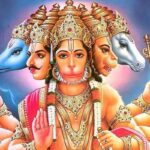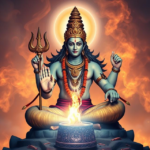In the Hindu lunar calendar, the month of Jyeshtha—falling between May and June—is associated with intense heat, purification, and spiritual discipline. Among its many auspicious days, Jyeshtha Mangal (ज्येष्ठ मंगळ) holds a unique place in the hearts of devotees, especially in Maharashtra and parts of North India. This day is observed on a Tuesday (Mangalvar) that falls during the Jyeshtha month. It is deeply associated with the worship of Lord Hanuman and the planet Mars (Mangal), both known for their fiery energy and protective qualities.
But Jyeshtha Mangal is more than just a day for worship—it holds spiritual, mythological, astrological, and healing significance. Let us explore the story behind Jyeshtha Mangal, its rituals, benefits, and why this day is believed to be especially potent for removing obstacles, diseases, and doshas related to Mangal Graha (Mars).
What is Jyeshtha Mangal?
Jyeshtha Mangal refers to a Tuesday that falls in the Jyeshtha month as per the Hindu Panchang (calendar). Not all Tuesdays are considered Jyeshtha Mangal; only those that fall during the lunar month of Jyeshtha qualify.
On this day, devotees:
Worship Lord Hanuman, considered the ruling deity of Mars.
Perform Mangal Dosh Nivaran puja.
Visit Hanuman temples and Navagraha shrines.
Engage in vrata (fasting) and japa (chanting) for protection and courage.
Mythological Background: The Story Behind Jyeshtha Mangal
1. Hanuman’s Birth and the Blessing of Mars
According to one version of Hindu mythology, Lord Hanuman was born on a Tuesday in the month of Jyeshtha during the Chitra Nakshatra, under the influence of the planet Mangal (Mars). It is said that on this particular day, Hanuman’s Bala roopa (child form) displayed immense energy and divine power.
The gods were in awe of Hanuman’s strength, and Mars—being the planet of power and energy—bestowed his blessings upon Hanuman. In return, Lord Hanuman promised that anyone suffering from Mangal Dosh or Kuja Dosh in their horoscope would be freed of its malefic effects if they worshipped him on Jyeshtha Mangal.
This mythological connection has made Jyeshtha Mangal a powerful day for Mars remedies.
2. The Mars-Hanuman Connection in Astrology
In Vedic astrology, Mars is a fiery planet that governs:
Courage
Aggression
Land and property
Blood and muscles
Marital conflict (especially in Manglik dosha)
When Mars is afflicted or weak in a horoscope, it may cause conflicts, accidents, health issues, or delays in marriage. Worship of Hanuman, especially on Jyeshtha Mangal, is recommended to pacify Mangal Graha and bring balance to one’s life.
Spiritual Significance of Jyeshtha Mangal
1. Purification of Karma
The heat of Jyeshtha symbolizes the burning away of impurities. Jyeshtha Mangal helps in purifying negative karmas associated with aggression, anger, ego, and past actions.
2. Channelizing Energy
Both Mars and Hanuman are associated with raw energy. Jyeshtha Mangal helps in channelizing this energy constructively—towards self-discipline, spiritual strength, and devotion.
3. Protection and Bravery
Worshipping Hanuman on this day is believed to offer protection from evil forces, black magic, and invisible obstacles.
4. Fulfilling Desires
Fasting and praying on Jyeshtha Mangal can lead to the fulfillment of righteous desires—especially regarding health, career, and relationships.
Rituals and Observances on Jyeshtha Mangal
1. Fasting (Vrat)
Many devotees observe a full-day fast from sunrise to sunset. Only fruits, water, and milk may be consumed. The vrat is dedicated to:
Lord Hanuman for strength and health
Planet Mars to balance astrological doshas
Fasting is broken after offering naivedya (food offering) to Hanuman and consuming prasad.
2. Hanuman Puja Vidhi
The ritual may include:
Applying sindoor and oil to Hanuman idols.
Offering red flowers, betel leaves, bananas, and boondi laddoo.
Chanting Hanuman Chalisa, Bajrang Baan, and Mangal stotra.
Lighting a mustard oil lamp with 5 wicks facing different directions for protection
3. Special Mars (Mangal) Remedies
Those with Mangal Dosh, delayed marriage, or health issues perform:
Navagraha Shanti puja
Mangal graha japa (10,000 to 11,000 times of Om Kraam Kreem Kroum Sah Bhaumaya Namah )
Donating red lentils, red cloth, jaggery, or copper items
4. Temple Visits
Devotees flock to Hanuman temples and Navagraha temples. Notable shrines include:
- Sankat Mochan Hanuman Temple, Varanasi
- Salasar Balaji, Rajasthan
- Alandi and Pune Hanuman temples in Maharashtra
- Karmanghat Hanuman Temple, Hyderabad
Astrological Benefits of Observing Jyeshtha Mangal
1. Relief from Manglik Dosha
Unmarried individuals suffering from Mangal Dosha in their birth chart often experience delays or problems in marriage. Fasting and worship on Jyeshtha Mangal can neutralize dosha and bring harmony.
2. Improved Mars Strength in Horoscope
People with weak or afflicted Mars can benefit from the energy alignment on this day.
3. Success in Competitive Exams and Sports
Mars governs competitive energy. Students, sportspersons, and professionals seek mental clarity, motivation, and success by praying on this day.
4. Control Over Temper and Impulses
Devotees gain emotional stability, reduced anger, and clearer decision-making ability
Health and Healing Through Jyeshtha Mangal
From an Ayurvedic and Yogic perspective, Jyeshtha is the time when Pitta (fire energy) increases in the body. Observing rituals on Jyeshtha Mangal:
- Cools the body and mind through spiritual discipline
- Helps in overcoming blood-related disorders
- Boosts muscular and immune strength
- Encourages pranayama and meditation for emotional healing
Jyeshtha Mangal and Hanuman Jayanti – Are They the Same?
No, although both celebrate Lord Hanuman, Jyeshtha Mangal and Hanuman Jayanti are different.
Hanuman Jayanti celebrates his birth (generally during Chaitra Purnima in North India).
Jyeshtha Mangal celebrates his spiritual strength and connection with Mars, usually for remedies and devotion.
Modern Relevance of Jyeshtha Mangal
In today’s world of stress, ambition, and conflict, the spiritual practices of Jyeshtha Mangal help people:
Stay grounded and balanced
Build resilience against emotional and astrological setbacks
Find devotional strength and direction in life
It is also a reminder that spiritual traditions offer timeless solutions for modern problems—through discipline, self-inquiry, and faith
Last Opinion
Jyeshtha Mangal is more than a date— it’s a gateway to strength, devotion, and transformation. It blends mythology, astrology, spirituality, and psychology into a holistic spiritual observance. Whether you’re seeking relief from Mangal Dosha, healing from emotional wounds, or just looking to reconnect with the divine power within, Jyeshtha Mangal offers a sacred opportunity.
As Lord Hanuman said in the Ramayana, “Where there is Ram bhakti, there is freedom from all fear.” Worshiping him on this powerful Tuesday can help one become fearless, focused, and fulfilled.
FAQs About Jyeshtha Mangal
Q1: Can non-Manglik people observe Jyeshtha Mangal?
Yes, absolutely. It is beneficial for everyone who wants to gain courage, focus, and protection.
Q2: What should be avoided on Jyeshtha Mangal?
Avoid anger, non-vegetarian food, alcohol, and gossip. Practice self-control and discipline.
Q3: How many times can Jyeshtha Mangal occur in a year?
Usually, 1–3 Tuesdays fall during the Jyeshtha month depending on the lunar calendar.
Related posts:
 Control Anger and Ego: Lessons from Hanuman on Jyeshtha Mangal
Control Anger and Ego: Lessons from Hanuman on Jyeshtha Mangal
 Boost Inner Strength and Discipline by Following Hanuman’s Path on Jyeshtha Mangal
Boost Inner Strength and Discipline by Following Hanuman’s Path on Jyeshtha Mangal
 Astrological Remedies for Manglik Dosha on Jyeshtha Mangal for Marital Harmony
Astrological Remedies for Manglik Dosha on Jyeshtha Mangal for Marital Harmony
 Why Celebrate Narak Chaturdashi? The Story, Significance, and Benefits of Worship
Why Celebrate Narak Chaturdashi? The Story, Significance, and Benefits of Worship
 Hanuman Jayanti 2025: Significance, Celebrations, Rituals, and Spiritual Insights
Hanuman Jayanti 2025: Significance, Celebrations, Rituals, and Spiritual Insights
 Mahashivratri: A Festival of Spiritual Awakening
Mahashivratri: A Festival of Spiritual Awakening
